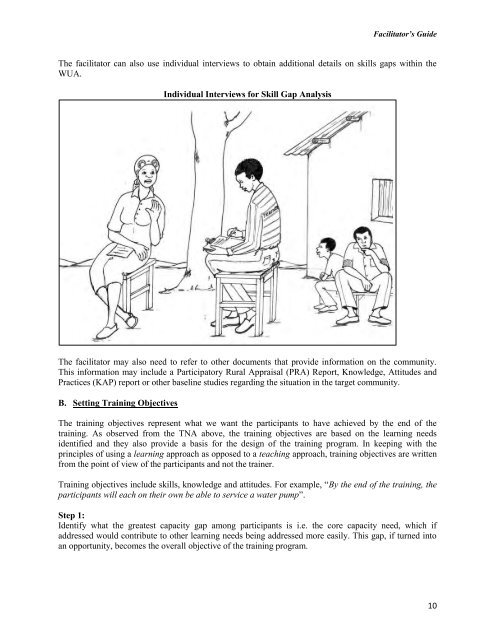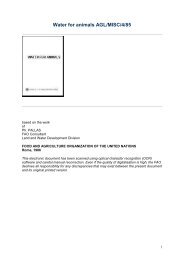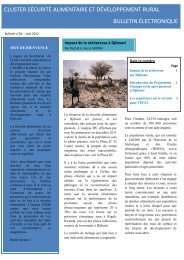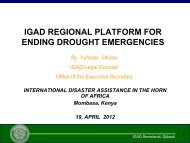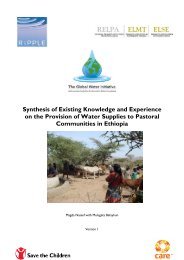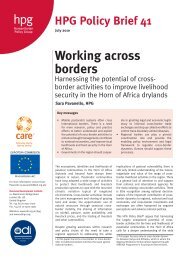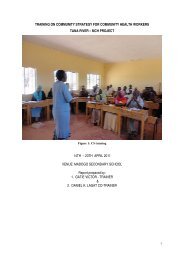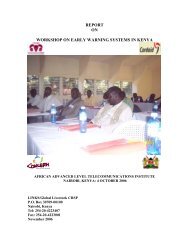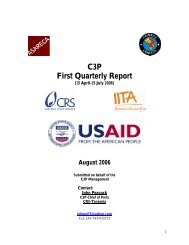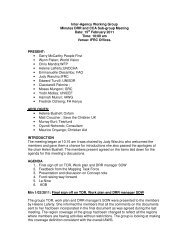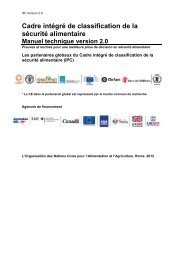- Page 1 and 2: EUROPEAN COMMISSIONREPUBLIC OF KENY
- Page 3 and 4: Table of ContentsContents .........
- Page 5 and 6: Wesfarmers LimitedWesfarmers - Appr
- Page 8 and 9: PV/R,PVCQ&ARBARBA ActRDDRev/expRFLR
- Page 11 and 12: Facilitator’s GuideFACILITATOR’
- Page 13 and 14: Facilitator’s Guide4. Different w
- Page 15 and 16: Facilitator’s GuidePyramid of Lea
- Page 17: Facilitator’s Guideb. How to carr
- Page 21 and 22: Facilitator’s GuideTo effectively
- Page 23 and 24: Facilitator’s GuideE. How to deve
- Page 25 and 26: Facilitator’s GuideEquipment and
- Page 27 and 28: Facilitator’s GuideBefore the tra
- Page 29 and 30: Module A: SustainabilityMODULE ASUS
- Page 31 and 32: Module A: SustainabilitySession A1:
- Page 33 and 34: Module A: SustainabilitySession A1:
- Page 35 and 36: Module A: SustainabilitySession A1:
- Page 37 and 38: Module A: SustainabilitySession A1:
- Page 39 and 40: Module A: SustainabilitySession A1:
- Page 41 and 42: Module A: SustainabilitySession A2:
- Page 43 and 44: Module A: SustainabilitySession A2:
- Page 45 and 46: Module A: SustainabilitySession A3:
- Page 47 and 48: Module A: SustainabilitySession A3:
- Page 49 and 50: Module A: SustainabilitySession A4:
- Page 52 and 53: Module A: SustainabilitySession A4:
- Page 54 and 55: Module A: SustainabilitySession A4:
- Page 56 and 57: Module A: SustainabilitySession A4:
- Page 58 and 59: Module A: SustainabilitySession A5:
- Page 60 and 61: Module A: SustainabilitySession A5:
- Page 62 and 63: Module A: SustainabilitySession A5:
- Page 64 and 65: MODULE BSESSION B1AppropriateFacili
- Page 66 and 67: Module B: WUA GovernanceSession B1:
- Page 68 and 69:
Module B: WUA GovernanceSession B1:
- Page 70 and 71:
Module B: WUA GovernanceSession B2:
- Page 72 and 73:
Module B: WUA GovernanceSession B2:
- Page 74 and 75:
Module B: WUA GovernanceSession B2:
- Page 76 and 77:
Module B: WUA GovernanceSession B3:
- Page 78 and 79:
Module B: WUA GovernanceSession B3:
- Page 80 and 81:
Module B: WUA GovernanceSession B3:
- Page 82 and 83:
SAMPLE CONSTITUTIONModule B: WUA Go
- Page 84 and 85:
Module B: WUA GovernanceSession B3:
- Page 86 and 87:
Module B: WUA GovernanceSession B3:
- Page 88 and 89:
Module B: WUA GovernanceSession B4:
- Page 90 and 91:
Module B: WUA GovernanceSession B4:
- Page 92 and 93:
Module B: WUA GovernanceSession B5:
- Page 94 and 95:
Module B: WUA GovernanceSession B5:
- Page 96 and 97:
Module B: WUA GovernanceSession B6:
- Page 98 and 99:
Module B: WUA GovernanceSession B6:
- Page 100 and 101:
Module B: WUA GovernanceSession B6:
- Page 102 and 103:
Module B: WUA GovernanceSession B7:
- Page 104 and 105:
Module B: WUA GovernanceSession B7:
- Page 106 and 107:
Module B: WUA GovernanceSession B7:
- Page 108 and 109:
Module B: WUA GovernanceSession B7:
- Page 110 and 111:
Module B: WUA GovernanceSession B8:
- Page 112 and 113:
Module B: WUA GovernanceSession B8:
- Page 114 and 115:
Module B: WUA GovernanceSession B8:
- Page 116 and 117:
Module C: Legal AffairsSession C1:
- Page 118 and 119:
Module C: Legal AffairsSession C1:
- Page 120 and 121:
Module C: Legal AffairsSession C1:
- Page 122 and 123:
Module C: Legal AffairsSession C2:
- Page 124 and 125:
Module C: Legal AffairsSession C2:
- Page 126 and 127:
Module C: Legal AffairsSession C2:
- Page 128 and 129:
Attachment 2: GENERIC OUTLINE OF CO
- Page 130 and 131:
Module C: Legal AffairsSession C3:
- Page 132 and 133:
FOR OFFICIAL USE ONLYModule C: Lega
- Page 134 and 135:
10. New accounts: The following are
- Page 136 and 137:
Module C: Legal AffairsSession C3:
- Page 138 and 139:
__________________ WATER PROJECTSCH
- Page 140 and 141:
Module C: Legal AffairsSession C3:
- Page 142 and 143:
Module C: Legal AffairsSession C3:
- Page 144 and 145:
Module C: Legal AffairsSession C3:
- Page 146 and 147:
MODULE CSESSION C4AppropriateFacili
- Page 148 and 149:
Module C: Legal AffairsSession C4:
- Page 150 and 151:
Module C: Legal AffairsSession C4:
- Page 152 and 153:
Module D: Human Resource Management
- Page 154 and 155:
Module D: Human Resource Management
- Page 156 and 157:
Module D: Human Resource Management
- Page 158 and 159:
Attachment 1: SAMPLE ORGANISATIONAL
- Page 160 and 161:
Attachment 3: Outline of Contract o
- Page 162 and 163:
Module E: Financial ManagementSessi
- Page 164 and 165:
Module E: Financial ManagementSessi
- Page 166 and 167:
Module E: Financial ManagementSessi
- Page 168 and 169:
Module E: Financial ManagementSessi
- Page 170 and 171:
Module E: Financial ManagementSessi
- Page 172 and 173:
Module E: Financial ManagementSessi
- Page 174 and 175:
Module E: Financial ManagementSessi
- Page 176 and 177:
Module E: Financial ManagementSessi
- Page 178 and 179:
Module E: Financial ManagementSessi
- Page 180 and 181:
Module E: Financial ManagementSessi
- Page 182 and 183:
Attachment 3: Setting household tar
- Page 184 and 185:
Module E: Financial ManagementSessi
- Page 186 and 187:
Module E: Financial ManagementSessi
- Page 188 and 189:
Module E: Financial ManagementSessi
- Page 190 and 191:
payment vouchers, outgoing cheques
- Page 192 and 193:
Module E: Financial ManagementSessi
- Page 194 and 195:
Module E: Financial ManagementSessi
- Page 196 and 197:
Bank Reconciliation StatementModule
- Page 198 and 199:
Module E: Financial ManagementSessi
- Page 200 and 201:
Module E: Financial ManagementSessi
- Page 202 and 203:
Module E: Financial ManagementSessi
- Page 204 and 205:
Module E: Financial ManagementSessi
- Page 206 and 207:
Module E: Financial ManagementSessi
- Page 208 and 209:
Module F: Water Management OptionsS
- Page 210 and 211:
Module F: Water Management OptionsS
- Page 212 and 213:
Module F: Water Management OptionsS
- Page 214 and 215:
Module F: Water Management OptionsS
- Page 216 and 217:
Module F: Water Management OptionsS
- Page 218 and 219:
Module F: Water Management OptionsS
- Page 220 and 221:
Module F: Water Management OptionsS
- Page 222 and 223:
Module F: Water Management OptionsS
- Page 224 and 225:
Module F: Water Management OptionsS
- Page 226 and 227:
Module F: Water Management OptionsS
- Page 228 and 229:
Module F: Water Management OptionsS
- Page 230 and 231:
Module F: Water Management OptionsS
- Page 232 and 233:
Module G: Environmental Health and
- Page 234 and 235:
Module G: Environmental Health and
- Page 236 and 237:
Module G: Environmental Health and
- Page 238 and 239:
Module G: Environmental Health and
- Page 240 and 241:
Module G: Environmental Health and
- Page 242 and 243:
Module G: Environmental Health and
- Page 244 and 245:
Module G: Environmental Health and
- Page 246 and 247:
Module G: Environmental Health and
- Page 248 and 249:
Module G: Environmental Health and
- Page 250 and 251:
Module G: Environmental Health and
- Page 252 and 253:
Attachment 2: Illustration on liqui
- Page 254 and 255:
Module H: Operation and Maintenance
- Page 256 and 257:
Module H: Operation and Maintenance
- Page 258 and 259:
Module H: Operation and Maintenance
- Page 260 and 261:
Module H: Operation and Maintenance
- Page 262 and 263:
Module H: Operation and Maintenance
- Page 264 and 265:
Module H: Operation and Maintenance
- Page 266 and 267:
Module H: Operation and Maintenance
- Page 268 and 269:
Module H: Operation and Maintenance
- Page 270 and 271:
Module H: Operation and Maintenance
- Page 272 and 273:
Module H: Operation and Maintenance
- Page 274 and 275:
Attachment 2: Replacement of rubber
- Page 276 and 277:
Module H: Operation and Maintenance
- Page 278 and 279:
Module H: Operation and Maintenance
- Page 280 and 281:
Module H: Operation and Maintenance
- Page 282 and 283:
Module H: Operation and Maintenance
- Page 284 and 285:
Module H: Operation and Maintenance
- Page 286 and 287:
c. Nalgonda technique;d. Bone char.
- Page 288 and 289:
Module H: Operation and Maintenance
- Page 290 and 291:
Module H: Operation and Maintenance
- Page 292 and 293:
Module H: Operation and Maintenance
- Page 294 and 295:
Module H: Operation and Maintenance
- Page 296 and 297:
MODULE HSESSION H4Appropriate Facil
- Page 298 and 299:
Module H: Operation and Maintenance
- Page 300 and 301:
Module H: Operation and Maintenance
- Page 302 and 303:
Module H: Operation and Maintenance
- Page 304 and 305:
Module H: Operation and Maintenance
- Page 306 and 307:
Module H: Operation and Maintenance
- Page 308 and 309:
Module H: Operation and Maintenance
- Page 310 and 311:
Module H: Operation and Maintenance
- Page 312 and 313:
Module H: Operation and Maintenance
- Page 314 and 315:
Module H: Operation and Maintenance
- Page 316 and 317:
Module H: Operation and Maintenance
- Page 318 and 319:
Module H: Operation and Maintenance
- Page 320 and 321:
Module H: Operation and Maintenance
- Page 323 and 324:
Module H: Operation and Maintenance
- Page 325 and 326:
Module H: Operation and Maintenance
- Page 327 and 328:
Module H: Operation and Maintenance
- Page 329 and 330:
TYPICAL RAINWATER HARVESTING SYSTEM
- Page 331 and 332:
Module H: Operation and Maintenance
- Page 333 and 334:
Attachment 1: Exercise on Rock Catc
- Page 335 and 336:
Module H: Operation and Maintenance
- Page 337 and 338:
Module H: Operation and Maintenance
- Page 339 and 340:
Module H: Operation and Maintenance
- Page 341 and 342:
Module H: Operation and Maintenance
- Page 343 and 344:
Module H: Operation and Maintenance
- Page 345 and 346:
Module H: Operation and Maintenance
- Page 347 and 348:
Module H: Operation and Maintenance
- Page 349 and 350:
Module H: Operation and Maintenance
- Page 351 and 352:
MODULE HSESSION H12Appropriate Faci
- Page 353 and 354:
Module H: Operation and Maintenance
- Page 355 and 356:
Module H: Operation and Maintenance
- Page 357 and 358:
Module H: Operation and Maintenance
- Page 359 and 360:
Module H: Operation and Maintenance
- Page 361 and 362:
Module H: Operation and Maintenance
- Page 363 and 364:
Module H: Operation and Maintenance
- Page 365 and 366:
Module H: Operation and Maintenance
- Page 367 and 368:
Attachment 1: Schematic diagram of
- Page 369 and 370:
Module H: Operation and Maintenance
- Page 371 and 372:
Module H: Operation and Maintenance
- Page 373 and 374:
3 Start butloses Power4 ExcessiveFu
- Page 375 and 376:
Module H: Operation and Maintenance
- Page 377 and 378:
Module H: Operation and Maintenance
- Page 379 and 380:
Module H: Operation and Maintenance
- Page 381 and 382:
Resource MaterialsRESOURCE MATERIAL
- Page 383 and 384:
Resource MaterialsMoojiman, A.; Sne
- Page 385:
Resource MaterialsWood S, Sawyer R,


